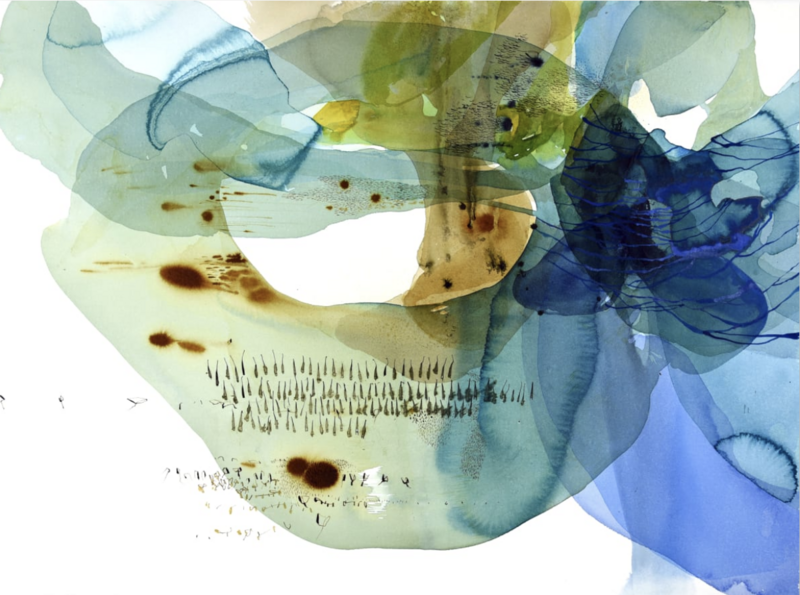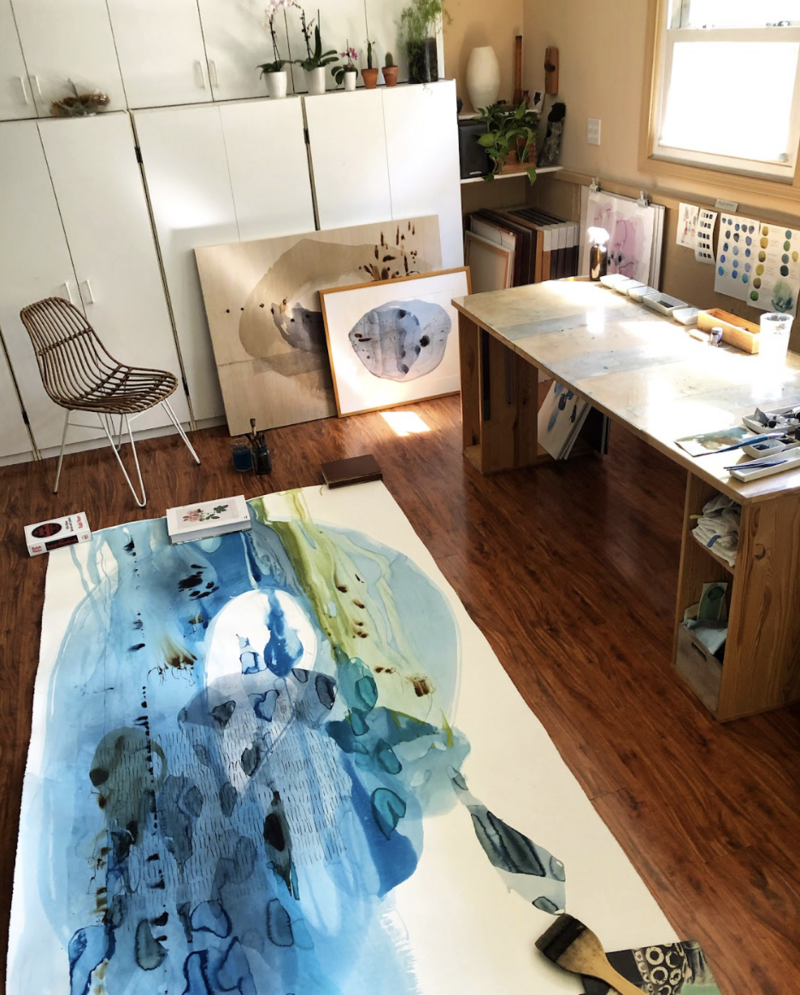Artwork Archive's Featured Artist Ana Žanić explores profound contrasts and innate human connections.
Ana Žanić's artwork, primarily created in watercolor, is a testament to the fluidity and spontaneity of life. Her technique, deeply rooted in the spontaneous and gestural act of mark-making, is a homage to calligraphy and symbolic communication.
Her paintings evoke the ethereal beauty of natural forms, resembling elements as diverse as abandoned landscapes, ancient scribbles, and celestial bodies.
The tension between the fluid calmness of watercolor and the energetic rhythm of drawing is central to her work. Watercolor as a medium holds inherent qualities of intimacy, lightness, and spontaneity.
It's this interplay of opposites—a dance between control and surrender—that infuses Ana's paintings with life.
Artwork Archive had the chance to chat with Ana Žanić about her creative process, why she doesn't think about the audience while she's painting, and how Artwork Archive makes her art career more manageable!
You can see more of her work on Discovery and learn more about her art practice below
.png)
Ana Žanić pictured next to one of her large pieces. Photo courtesy of the artist.
Do you have a favorite or most satisfying part of your process?
The moment just before I start, standing in front of a blank piece of watercolor paper is full of potential.
I don't yet know where exactly I am going, but I am ready to take the plunge and be surprised! That is my favorite part of my creative process, and It never gets old.
The tension between fluidity and energy is a central theme in your work. How do you balance these opposing qualities when creating a painting?
Most of my work consists of watercolor washes juxtaposed with the intricate mark-making.
I believe this balance results from respecting the materials' inherent qualities; I let the watercolor be fluid, transparent, and organic, and then contrast it with the drawing's natural rhythm and energy of line and mark-making.
The opposing qualities end up working in partnership and enhance each other.

Ana Žanić, Viridis I and II, 30 x 22 in
What impact do you hope your work will have on those who view it?
What interests me in my work is capturing the moment, a sense of life and intimacy.
Even when I create on a large scale I want the result to be gentle and delicate—there are always tiny marks that draw you in, invite you to come very close, and be really intimate with the work.
I love when my art speaks to the viewer, on this quiet, intimate level, and opens up like a new mysterious portal to enter. However, I don't think about the audience when I create. During the process, I only listen to my voice.
Thinking about the audience is very dangerous for me—I find it both kills the joy of making and results in sub-par work.
You mention the importance of intuitive and spontaneous processes in your art practice. Could you elaborate on how you approach this aspect of your work?
My art practice gives me the license to be unconcerned with the outcomes, and to enjoy a sense of flow.
I grew up in a creative home. There was a constant exchange of ideas and lots of music and humor.
My parents were direct, honest, spontaneous, and creative people. They brought me up without many boundaries. I believe my intuitive approach to creating naturally stems from those very early experiences of freedom of expression.
.png)
Ana Žanić with a work in progress. Photo courtesy of the artist.
What does success as an artist mean to you?
The idea of success changes over time and with experience, and is, of course, very different for each individual.
When I was younger, being accepted to art school felt like an enormous success; I remember I felt like I was on top of the world.
Later, success meant having my first solo exhibition. I always wanted to know if I could make a living off my work, and when I started working with galleries, I felt that was the next big accomplishment.
However, the importance of staying true to my vision always was and still is a number one priority for me. I would say that, for me, success is being able to do what I love and also be recognized and rewarded for that work.
How do you handle creative blocks and find the motivation to keep creating?
I don't really experience creative blocks. I never get tired of the creative process. Of course, there can be various obstacles in the path that make it difficult to create.
If you are sick, caring for a newborn or a family member, if you don't have much time, if you don't have a studio space ... all those things are very real issues.
Whenever I find myself in front of an obstacle, I simplify my process. I simplify as much as I can and set very small yet attainable goals. Then I say to myself "One step at a time."
Artwork Archive Tip:
Making small, attainable goals for your art career is the best way to accomplish them! Here's a free worksheet that will help you make SMART goals for your art business.

Ana Žanić, Flow Earth W, 22 x 30 in
How do you use Artwork Archive on a daily basis?
I work with galleries, consultants, and private clients daily so it's critical for me to stay organized and keep track of my inventories.
With Artwork Archive, I can easily input my artwork and all its info, and keep track of each work's current location, where and when a particular piece was exhibited, and if and when it was sold.
I can also keep a detailed contact list and connect the works and sales to those contacts. Two features I especially like are the Public Profile and the Private Rooms.
My Public Profile works as an additional mini website of my work, and it offers me exposure to a larger audience.
I often use password-protected Private Rooms to create customized portfolios for a specific project or a private client.
I find Artwork Archive to be simple to use, versatile, and highly customizable to manage my artwork inventory.
Artwork Archive Tip:
With Artwork Archive, you can view important insights about your art business. Learn which locations had the most artwork sales or which contact is your best collector.
Learn more about how to use these tools here.
What advice would you give an artist who’s just starting out in their professional career?
So many aspects of an artistic career are unpredictable and closely tied to specific circumstances, chance, and luck.
Hone in on your own voice and listen to it with trust. Ultimately, your voice is your main guide.

Inside Ana Žanić's studio. Photo courtesy of the artist.
Ana Žanić uses Artwork Archive to keep track of her artwork, create Private Rooms, send professional reports to clients, and a lot more.
You can make an online portfolio, catalog your artwork, and generate reports like inventory reports, tear sheets, and invoices in seconds with Artwork Archive. Take a look at Artwork Archive's free trial and start growing your art business.


.png)

80ef.png?1694636989)
5e17.png?1683835079)

1bbc.png?1693435948)
